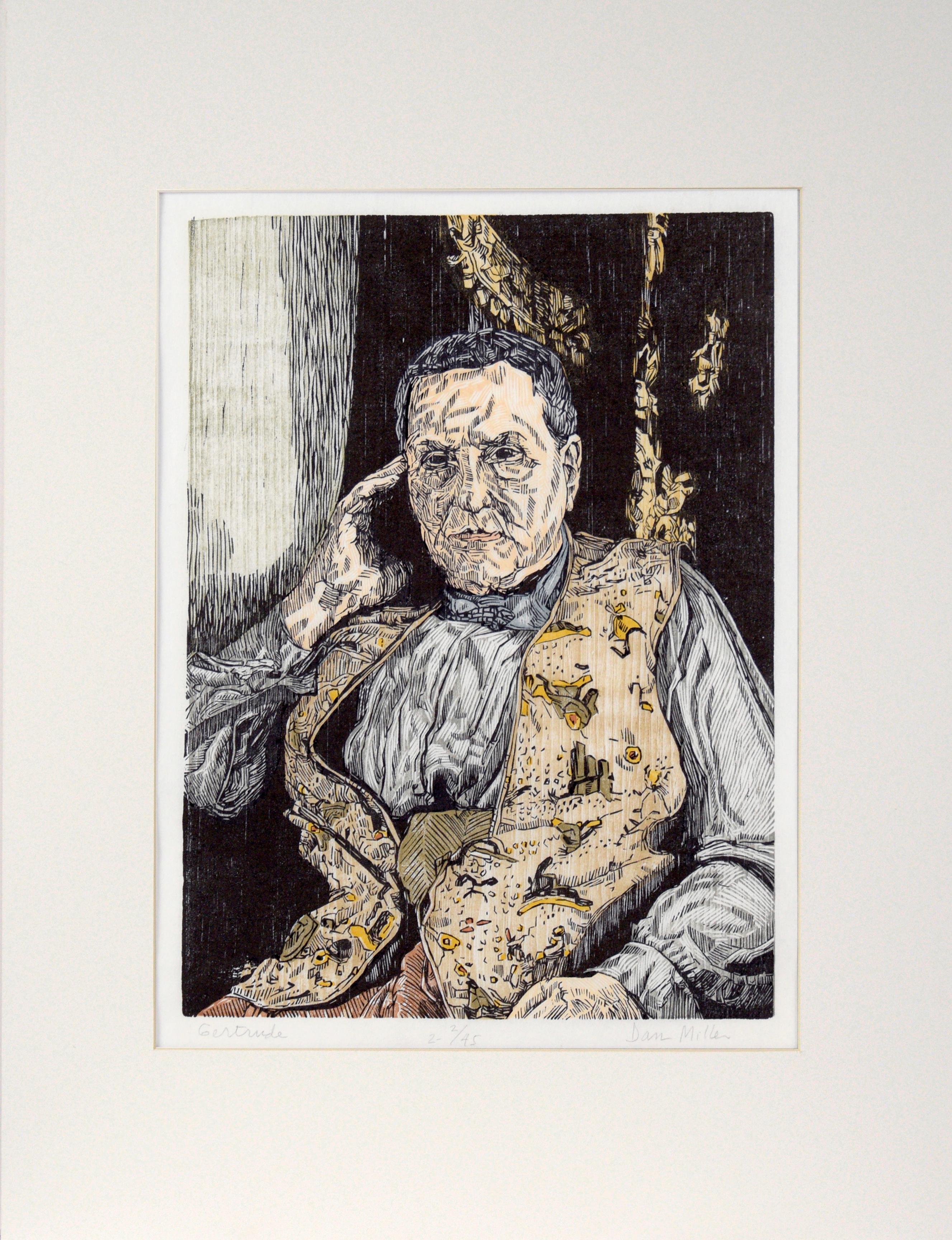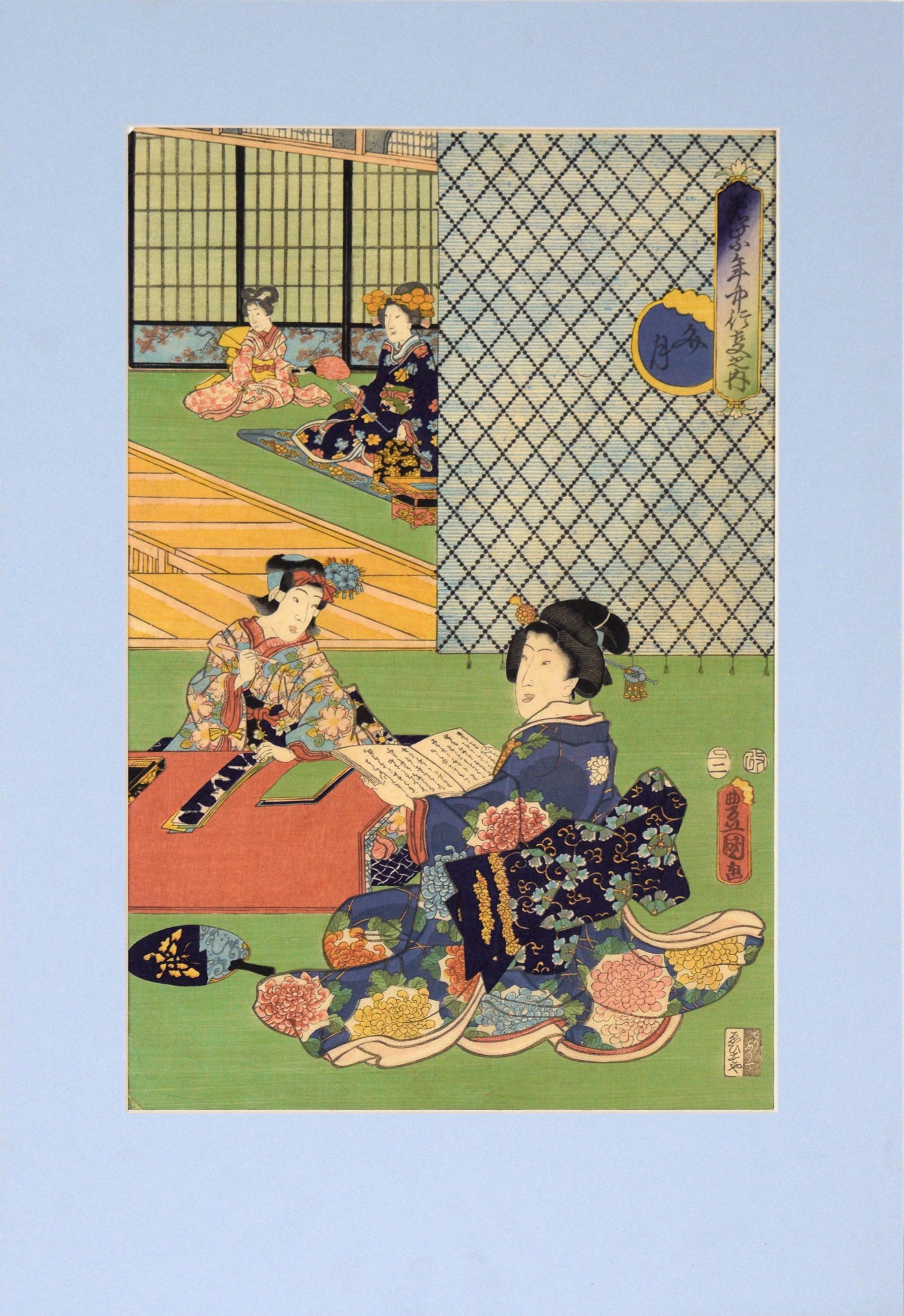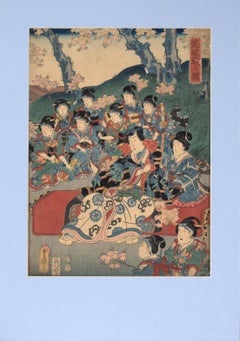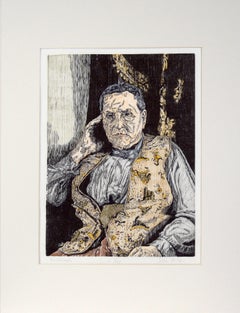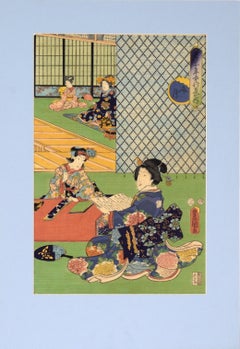Items Similar to "Femme 5" Figurative Woodblock on Rice Paper
Want more images or videos?
Request additional images or videos from the seller
1 of 16
Shiko Munakata"Femme 5" Figurative Woodblock on Rice Paper1954
1954
About the Item
"Femme 5" Figurative Woodblock on Rice Paper
Bold figurative composition by Shiko Munakata (Japanese, 1903-1975). A woman is shown in a squatting position, with her head tilted. She is surrounded by leaves and branches, against a pale red background. Woodblock print with hand-applied color from the back which bleeds through to the front, from the series Munakata’s instantly recognizable style. From the Shokeisho – In Praise of the Bell Valley- Series of 24 images (Munakata’s first major post-war work) 1945. Munakata is credited with turning the craft of print-making into a fine-art
The series was Munakata's first after the Pacific War. Each print was about 455 x 327 mm and hand-colored from the back. Munakata initially used the technique of urazaishiki ("back coloring": 裏彩色), a term associated with paintings, in 1938 when he brushed colors on the back of 12 prints in his series Kannon-gyô hangakan (Print volume of the Kannon Sûtra: 観音経版画巻) In the Shôkei series, each contorted figure virtually fills the picture space as flat black forms whose details (heads, torsos, limbs) were engraved or gouged out in reserve, apparently the first time the artist used this technique; it became a signature method for the remainder of his career. These bold "white" lines were for the most part hand-colored on the reverse in blue, purple, or tan, allowing the fluid colors to bleed through the paper to the front. The example immediately above is titled Raimon no saku
Presented in a wood frame with a cream mat.
Artists chop lower right margins.
Frame size: 27.25H x 23"W
Image size: 19.75"H x 15"W
Shiko Munakata is by many regarded as one of the most significant modern Japanese artists of the twentieth century. His art work consists of paintings, prints, ceramics and calligraphy. Looking at his art work, the way he produced it and his fame, one could be tempted to call him the Japanese Picasso of the twentieth century - in every aspect.
Born in Aomori Shiko Munakata was born as the son of a blacksmith in Aomori Prefecture, located in the North of Japan's main island. He first began to paint in oil as a self-taught artist. Later in 1924 he went to Tokyo to study art.
Three years after the artist's death, the city of Aomori opened the Munakata Shiko Memorial Museum of Art. The museum web site has one page with a summary of the career of the artist in English.
At the age of 23 Munakata Shiko saw a woodblock print by Sumio Kawakami and decided to try woodblocks himself. Under the guidance of Unichi Hiratuka he learned the art of making moku-hanga - woodblock prints. Three years later he exhibited four woodblocks at the Shunyokai exhibition.
From then on Munakata Shiko was a hanga artist - a print artist. He continued to exhibit and by and by his reputation grew.
After World War II had ended, the artist became famous outside Japan. His works were shown at the Lugano Print Exhibition in 1952, the Sao Paulo Biennal in 1955, the Venice Biennal in 1956. In each of these exhibitions he was awarded with first prizes. After these successful exhibition, Munakata went to the U.S., where he lectured at different universities and had numerous solo exhibitions.
Munakata Shiko preferred to call his prints banga, which could be translated like picture made from a wooden panel.
Munakata was a practicing Buddhist. Many of his prints and paintings show religious subjects. Other subjects are taken from Japanese legends or from nature.
Munakata's prints are larger than the traditional Japanese oban (10x15 inches = 25.4x38 cm) size. With his larger-sized prints he followed Western contemporary artist's and the buying habits of Western clients. Japanese homes are usually small and have little wall space to hang art work and therefore Japanese art buyers tend to buy smaller sizes.
A Munakata print is usually in black and white. The techniques he used are woodblocks, woodcuts and lithographs. Like Pablo Picasso, Shiko Munakata worked spontaneously, fast and was extremely prolific.
In many early works, Munakata added colors by hand on the front surface of the prints, but he found it obscured the black keyblock lines, ruining the design. Around 1945, the aforementioned Yanagi Sôetsu, head of the Japan Folk Art Museum in Tokyo, and art critic, philosopher, and founder of the mingei (folk art: 民芸) movement in Japan in the late 1920s and 1930s, suggested coloring from the verso and allowing the pigments to bleed through to the front. Munakata was quite pleased with the results and called the technique urazaishiki ("back-coloring: 裏彩色). He would incorporate this type of coloring whenever he believed using only sumi (black) pigment did not achieve the particular feeling he desired in a design.
Munakata pattern of thunderIn 1945, just after the end of the war, Munakata produced another important set on a Buddhist theme, this time 24 images (20 were female) intended to be mounted as a pair pf six-fold screens (two images on each leaf). Titled Shôkei shô hangakan (Print volume in praise of Shôkei: 鐘渓頌版画巻), the series was a tribute to Munakata's friend and supporter in the Mingei (Folk Art: 民芸) movement, Kawai Kanjirô (河井寬次郎 1890-1966), one of Japan's great twentieth-century potters (who refused all official honors, including the designation of Ningen Kokuhô 人間国宝, Living National Treasure). Kanjirô's self-made, eight-chamber kiln in the Gojô district of Kyoto was called "Shôkei'"(Valley of the Bell: 鐘渓). Munakata showed 12 of the 24 prints at the aforementioned Third Sao Paulo Biennale in 1955.
- Creator:Shiko Munakata (1903 - 1975, Japanese)
- Creation Year:1954
- Dimensions:Height: 27.25 in (69.22 cm)Width: 23 in (58.42 cm)Depth: 1.5 in (3.81 cm)
- Medium:
- Movement & Style:
- Period:
- Condition:Overall good condition. Horizontal crease visible.
- Gallery Location:Soquel, CA
- Reference Number:Seller: DBH95861stDibs: LU54215399792
Shiko Munakata
Shiko Munakata is by many regarded as one of the most significant modern Japanese artists of the twentieth century. His art work consists of paintings, prints, ceramics and calligraphy. Looking at his art work, the way he produced it and his fame, one could be tempted to call him the Japanese Picasso of the twentieth century - in every aspect. Born in Aomori Shiko Munakata was born as the son of a blacksmith in Aomori Prefecture, located in the North of Japan's main island. He first began to paint in oil as a self-taught artist. Later in 1924 he went to Tokyo to study art. Three years after the artist's death, the city of Aomori opened the Munakata Shiko Memorial Museum of Art. The museum web site has one page with a summary of the career of the artist in English. At the age of 23 Munakata Shiko saw a woodblock print by Sumio Kawakami and decided to try woodblocks himself. Under the guidance of Unichi Hiratuka he learned the art of making moku-hanga - woodblock prints. Three years later he exhibited four woodblocks at the Shunyokai exhibition. From then on Munakata Shiko was a hanga artist - a print artist. He continued to exhibit and by and by his reputation grew. After World War II had ended, the artist became famous outside Japan. His works were shown at the Lugano Print Exhibition in 1952, the Sao Paulo Biennal in 1955, the Venice Biennal in 1956. In each of these exhibitions he was awarded with first prizes. After these successful exhibition, Munakata went to the U.S., where he lectured at different universities and had numerous solo exhibitions. Munakata Shiko preferred to call his prints banga, which could be translated like picture made from a wooden panel. Munakata was a practicing Buddhist. Many of his prints and paintings show religious subjects. Other subjects are taken from Japanese legends or from nature. Munakata's prints are larger than the traditional Japanese oban (10x15 inches = 25.4x38 cm) size. With his larger-sized prints he followed Western contemporary artist's and the buying habits of Western clients. Japanese homes are usually small and have little wall space to hang art work and therefore Japanese art buyers tend to buy smaller sizes. A Munakata print is usually in black and white. The techniques he used are woodblocks, woodcuts and lithographs. Like Pablo Picasso, Shiko Munakata worked spontaneously, fast and was extremely prolific. Shiko Munakata died in Tokyo in 1975 at the age of 72.
About the Seller
5.0
Platinum Seller
Premium sellers with a 4.7+ rating and 24-hour response times
Established in 1986
1stDibs seller since 2014
2,875 sales on 1stDibs
Typical response time: <1 hour
- ShippingRetrieving quote...Shipping from: Soquel, CA
- Return Policy
Authenticity Guarantee
In the unlikely event there’s an issue with an item’s authenticity, contact us within 1 year for a full refund. DetailsMoney-Back Guarantee
If your item is not as described, is damaged in transit, or does not arrive, contact us within 7 days for a full refund. Details24-Hour Cancellation
You have a 24-hour grace period in which to reconsider your purchase, with no questions asked.Vetted Professional Sellers
Our world-class sellers must adhere to strict standards for service and quality, maintaining the integrity of our listings.Price-Match Guarantee
If you find that a seller listed the same item for a lower price elsewhere, we’ll match it.Trusted Global Delivery
Our best-in-class carrier network provides specialized shipping options worldwide, including custom delivery.More From This Seller
View AllDueling with Cherry Blossoms - Tales of Genji - Japanese Woodblock
By Utagawa Kunisada (Toyokuni III)
Located in Soquel, CA
Dueling with Cherry Blossoms - Tales of Genji - Japanese Woodblock
Rightmost panel a triptych, depicting a group of children and a samurai watching a "duel" with cherry blossoms. Th...
Category
1850s Realist Figurative Prints
Materials
Printer's Ink, Rice Paper, Woodcut
"Gertrude" - Eleven Color Woodcut on Laid Rice Paper 2/45
Located in Soquel, CA
"Gertrude" - Eleven Color Woodcut on Laid Rice Paper 2/45
Portrait of a woman by artist, Dan Miller (American, b. 1928) made by layers of color in woodcuts in Miller's signature sty...
Category
1980s Contemporary Portrait Prints
Materials
Rice Paper, Laid Paper, Woodcut
$440 Sale Price
20% Off
Annual Events for Young Murasaki (July) - Tales of Genji - Japanese Woodblock
By Utagawa Kunisada (Toyokuni III)
Located in Soquel, CA
Annual Events for Young Murasaki (July) - Tales of Genji - Japanese Woodblock
Rightmost panel a triptych, depicting monthly events for Wakamurasaki (Young Murasaki). This is the month of July. There appears to be a lesson taking place, possibly for writing or poetry.
Artist: Toyokuni III/Kunisada (1786 - 1864)
Publisher: Ebisu-ya Shoshichist
Presented in a new blue mat.
Mat size: 19"H x 13"W
Paper size: 14.5"H x 10"W
Commentary on the triptych:
In the Edo period, Tanabata was designated as one of the five seasonal festivals, and became an annual event for the imperial court, aristocrats, and samurai families, and gradually came to be celebrated by the general public. Its origins are said to be a combination of the Kikoden festival, which originated from the Chinese legend of Altair and the Weaver Girl, and Japan's ancient Tanabata women's faith. Ink is ground with dew that has accumulated on potato leaves, poems and wishes are written on five colored strips of paper, which are then hung on bamboo branches to celebrate the two stars that meet once a year. Although the illustration is a Genji painting...
Category
1850s Realist Figurative Prints
Materials
Printer's Ink, Rice Paper, Woodcut
"Lady Holding a Baby" - Woodblock Print on Laid Rice Paper
Located in Soquel, CA
"Lady Holding a Baby" - Woodblock Print on Laid Rice Paper
Elegant woodcut print by Stephen White (American, b. 1939). In an early example of White's signature style, a stylized, mi...
Category
1970s Modern Figurative Prints
Materials
Rice Paper, Woodcut
"First Horse Day, 1896" - Chiyoda Palace - Japanese Woodblock by Chikanobu Yoshu
By Toyohara Chikanobu
Located in Soquel, CA
"First Horse Day, 1896" - Chiyoda Palace - Japanese Woodblock by Chikanobu Yoshu
Colorful and expressive court scne by Toyohara Chikanobu,"Yoshu" (Japanese, 1838-1912).
This is the r...
Category
1890s French School Figurative Prints
Materials
Ink, Rice Paper, Woodcut
Mitate of a Daimyo's Procession Crossing Ryogoku Bridge - Woodblock Print
By Keisai Eisen
Located in Soquel, CA
Mitate of a Daimyo's Procession Crossing Ryogoku Bridge - Woodblock Print
Woodblock print of a procession by Keisai Eisen (Japanese, 1790–1848). Terrific triptych of a procession of...
Category
Early 19th Century Edo Figurative Prints
Materials
Ink, Rice Paper, Woodcut
You May Also Like
VIII from Les Marionnettes, Abstract Gouache and Drypoint by Hans Bellmer
By Hans Bellmer
Located in Long Island City, NY
Artist: Hans Bellmer, German (1902 - 1975)
Title: VIII from Les Marionnettes
Year: 1969
Medium: Hand-colored Drypoint Etching on Rice Paper, signed in pencil
Image Size: 12 x 11 inch...
Category
1960s Surrealist Figurative Prints
Materials
Gouache, Rice Paper, Drypoint
The Football Player, Woodcut Print on Rice Paper by Leonard Baskin
By Leonard Baskin
Located in Long Island City, NY
This woodcut print was created by American artist Leonard Baskin. Baskin is well known for his somewhat grotesque, intricate, surreal drawings and natural subject matter. This print ...
Category
1950s Surrealist Figurative Prints
Materials
Rice Paper, Woodcut
Fiorentino, Woodcut Print on Rice Paper, circa 1950 by Leonard Baskin
By Leonard Baskin
Located in Long Island City, NY
This woodcut print was created by American artist Leonard Baskin. Baskin is well known for his somewhat grotesque, intricate, surreal drawings and natural subject matter. This print ...
Category
1950s Surrealist Figurative Prints
Materials
Rice Paper, Woodcut
Dierdre, Woodcut Print on Rice Paper by Leonard Baskin
By Leonard Baskin
Located in Long Island City, NY
This woodcut print was created by American artist Leonard Baskin. Baskin is well known for his somewhat grotesque, intricate, surreal drawings and natural subject matter. This print ...
Category
1950s Surrealist Figurative Prints
Materials
Rice Paper, Woodcut
Women in a Garden
By Toyohara Chikanobu
Located in Austin, TX
Tohoyara Chikanobu
"Women in a Garden"
Woodcut print on Paper
Tryptich totalling 13 x 29"
Framed size 20 x 35"
The triptych of woodcut prints features a classic scene of a garden in...
Category
Late 19th Century Figurative Prints
Materials
Rice Paper, Woodcut
Sumo Wrestling Tournament
By Toyohara Kunichika
Located in Austin, TX
Toyohara Kunichika
"Sumo Wrestling Tournament"
Woodcut Print on Paper
13.5 x 28.5"
Framed size 35 x 20"
The print pictures an exciting scene featuring t...
Category
Late 19th Century Figurative Prints
Materials
Rice Paper, Woodcut
Price Upon Request
Recently Viewed
View AllMore Ways To Browse
Call Bell
Rice Paper Wall Art
Foldable Picture Frame
Folding Picture Frames
Japan Woodblock Set
Vintage Treasure Island
Large Picture Frames Pair
Pair Small Picture Frames
Japanese Buddhist Screen
Japanese Screens Six Fold
12 Panel Screen
Large Japanese Folding Screen
Wood Female Torso
Japanese Kannon
Hand Painted Japanese Screen Watercolor
Japanese Folding Screen Rice Paper
Soetsu Yanagi

